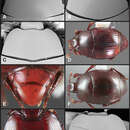Description
provided by Zookeys
Length: 1.87–1.90 mm, width: 1.44–1.47 mm; body rufescent, elongate, ovoid, generally widest behind humeri; frons moderately depressed at middle, lacking microsculpture; central portion of frontal stria varied from complete to fragmented to absent; labrum broad, almost 3× as wide as long, emarginate apically; sides of pronotum usually sinuate in basal third, rounded to subangulate to anterior corner; pronotal disk with fine, sparse ground punctation, lacking coarser lateral punctures, with shallow, poorly defined depression along and behind anterolateral portion of submarginal stria; marginal pronotal stria generally descending to hypomeron at anterior corner, delimiting antennal cavity beneath, often effaced entirely; anterior and lateral portions of submarginal stria generally connected, continuous along anterior and lateral margins, arched forward to near anterior pronotal corner, outward to nearly intersect lateral margin, then diverging from margin slightly, running parallel to margin in basal half; elytra with two complete epipleural striae, with outer subhumeral stria fine, present in apical third, inner subhumeral stria absent, striae 1-4 complete, 5th stria present in apical half, sutural slightly longer; venter with microsculpture on prosternum, mesoventrite, and anterior fourth of metaventral disk, with rudimentary sculpturing on the 1st abdominal ventrite; prosternal keel, mesoventrite, and anterior half of metaventrite markedly depressed, especially in males, posterior half of metaventrite convex and prosternal lobe deflexed; prosternal keel weakly emarginate at base, carinal striae complete, with weak secondary striae; some populations with distinct presternal swelling at base of prosternal lobe; mesoventral margin weakly projecting, with marginal stria interrupted; mesometaventral stria arched forward to near anterior mesoventral margin; lateral metaventral stria extended toward middle of metacoxa, slightly abbreviated apically; 1st abdominal ventrite with single, abbreviated lateral stria; propygidium and basal half of pygidium with conspicuous microscuplture; propygidial punctures very small, irregularly separated by about 5× their diameters; pygidium elongate, about 1.3 times as long as maximum width, with fine ground punctures, few coarser punctures in basal corners; marginal pygidial stria fine, obsolete along basal half or more of margin, often secondarily interrupted. Male gentialia extremely similar to those of Operclipygus hamistrius (see Figs 57A–D), differing as follows: T8 broader, with deeper basal emargination; S8 slightly more elongate and with narrower, more attenuate apical guides; S9 with apex slightly narrower and base slightly broader; tegmen (Fig. 57L) very slightly shorter, broader, dorsoventral curvature more even, less abruptly curved ventrad.
- license
- cc-by-3.0
- copyright
- Michael S. Caterino, Alexey K. Tishechkin
- bibliographic citation
- Caterino M, Tishechkin A (2013) A systematic revision of Operclipygus Marseul (Coleoptera, Histeridae, Exosternini) ZooKeys 271: 1–401
- author
- Michael S. Caterino
- author
- Alexey K. Tishechkin

